Communication has always been a key characteristic of our society, and it is one of the underlining features of our success. Evolution has allowed us to acquire the ability to speak and but also to develop other types of communications. Verbal, non-verbal, written and visual are a few examples. However, our ability to send information goes far beyond what our eyes can see.
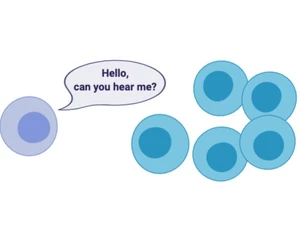
Created with Biorender
Just like we are able to use communication to alert those around us of any possible danger, our internal fighters have to be able to do the same. Imagine the number of microorganisms we are being exposed to every single day. Being able to inform nearby cells of possible threats is crucial. Therefore, in order to properly function, our immune system needs to have an exceptional ability to communicate.
But how does this communication actually work? What happens if a cell wants to tell X to a group of cells, and Y to another group of cells? In our language we can say pretty much anything using a combination of words, but what about cells? How does such a complex level of communication happen at a molecular level? … Hold on to your seat, and let’s talk about how cells talk!
Cytokines: the words of our molecular language
In order to communicate, our cells have evolved a very cool mechanism which includes a signalling molecule and a receptor. The transfer of information occurs when the signalling molecule binds to the receptor, which ultimately modifies the cell receiving the signal.
These signalling molecules are called cytokines, and they can be released by many different cells in our body (not just immune cells). Most cytokines are soluble factors meaning that they are released from the cell, but some can stay bound to the cellular membrane. Cytokines will act on receptors, which are expressed by a vast number of cell types. Together this means that almost all cells in our body are able to send and receive information using this mechanism.
The word cytokine can bring fear to many people since there are not just one, two or three different cytokines, but many different FAMILIES of cytokines. Each family has different members, each member is released by different cell types (which depends on the situation), and the combination of many different cytokine actions is what leads to the desired cellular result. Breath… I know, it sounds very complicated. But trust me, the idea behind it is very straightforward: sending information to the correct cell, at the correct time, to lead to specific changes!
By now you can already appreciate that the beauty of the immune system is not the act of a single cell (or cell type), but the regulated network of events, that together help us stay healthy. And many times, this regulation is dictated by cytokines!
The transfer of information
Imagine that cell X has been placed in a situation of stress. Instead of freaking out, this cell needs to alert the other cells around it. One way to achieve this is by producing cytokines. Cell X will produce and release a high number of cytokine molecules in its surrounding. A signal will occur if this molecule happens to find a receptor. But note, that the binding of the cytokine to the receptor is very specific, meaning that each type of cytokine has its unique receptor.
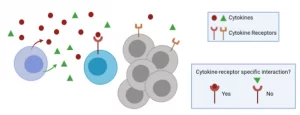
Cell x (in purple, left) releasing two different types of cytokines in the environment. Cell y (in blue, middle) expressing the receptor specific to the red (circular) cytokine. Cells in gray (right) do not express the specific cytokine receptor and therefore won’t receive the “information” sent by cell x. Created with BioRender
In our scenario, cell Y happens to express the specific cytokine receptor. Note that you should not picture the receptor as an “arm” that will go search for the cytokine. The receptor stays at the surface, and due to the high number of cytokine molecules in the environment, there is a high chance of a cytokine landing on the receptor. This binding allows for the information to translate into changes inside the receiving cell.
The cytokine-receptor interaction leads to the activation of what is called a “signalling cascade”. Yes, a cascade (but more like a tiny, tiny, molecular cascade) is exactly what happens after the initial binding. Picture this. Inside of the receiver cell, there are many proteins present in an “inactive” state. As soon as the cytokine-receptor biding occurs, they will change into the “active” state, one after the other. Meaning that the initial signal will activate protein 1, which will then acquire the ability to activate protein 2, which… you guess.. acquire the ability to activate proteins 3, and so on…
So… what’s at the end?
Well, many different things can happen “at the end” of this molecular cascade, but an underlying feature is the ability to generate new proteins.
In our scenario, prior to the signal, cell Y was just chilling. It did not require proteins to take care of any danger. So, this cell didn’t express such proteins. However, cell Y still has the ability to generate a wide range of proteins thanks to its internal “manual” known as the DNA. DNA holds the information necessary to produce proteins, and a cell can access this information when in need.
So, “at the end” of a signalling cascade, cells can activate a type of protein called transcription factors. Ok, I have to admit that many things in science make me happy, but transcription factors hold a very high place on my “happy list”!
Transcription factors are proteins that can bind to our DNA and turn on (or off) the production of a specific protein. Some transcriptor factors are just like “master regulators” which are able to turn on the production of a set of proteins. It sounds like the perfect idea if you want your cell to go from “chilling” to “fighting”. Turning on the “fighting” set of genes (that will make proteins) by activating the correct transcription factors, and your cell is ready to go! Isn’t that just awesome?
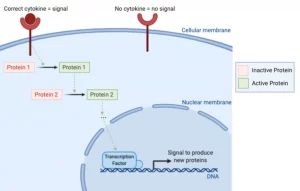
Following the binding of the cytokine to its receptor, a signalling cascade will occur. A high number of different proteins will get activated in this process. Many times, at the end of the cascade, there will be the activation of a transcription factor that can turn on the production of new proteins. Created with BioRender.
More than just a danger signal
It is important to note that cytokines are much more than signalling molecules following danger. Cytokines are crucial to many aspects of cell biology. The wide range of different responses occurs due to the high number of cytokine types, but also by the combination of cytokine signals that one cell can receive.
Moreover, different cells can express different types of receptors at different time points. This dynamic regulation of receptor expression is essential to allow cells to respond, or not, to environmental cues. All these variables together, allow for a wide range of “communication” to occur.
Can it go wrong?
Now you know that cytokines play a crucial role to ensure we stay healthy, but just like everything else… too much of a good thing can be bad. Many different diseases actually result from an inappropriate release of such molecules. Either due to the inappropriate release of cytokine amount or cytokine type.
Sepsis is a classical example of communication going very wrong. This is an extremely dangerous condition that occurs following the overactivation of our immune system. After injury or infection, cytokines are released to ensure the danger is contained. However, during sepsis, there is a massive release of cytokines, a phenomenon known as cytokine storm.
Instead of helping us, this high level of information over activates many immune cells, which then start to attack our own body. Unfortunately, this bad communication can lead to organ failure and even death. What was supposed to be an easy task, the removal of the infection or the repairing tissue, can be become life-threatening due to an unregulated release of cytokines.
Harnessing the power of cytokines
At the right dose, however, cytokines are extremely beneficial to us. Therefore, scientists have been exploiting their power to treat different diseases. Cytokine treatments are used to help patients suffering from autoimmune diseases and even cancer.
As I mentioned before, autoimmune diseases occur when our immune cells wrongly attack our own healthy cells. These immune cells that were supposed to be “chilling” are now fighting, which can have very detrimental effects. Therefore, by giving an appropriate cytokine that provides the “hey stop attacking, everything is ok” information, we can help patients with autoimmune diseases. Now you see how crucial it is for us to further understand the role cytokines in each situation.
Cytokine action is one amazing example of how cells are able to talk! I have to admit that I do talk a lot most of the time, but I am 100% sure my cells talk way more than I do… and… I might be using this excuse in the near future. See you next week!
From your immunologist – in training,
Stefanie Valbon
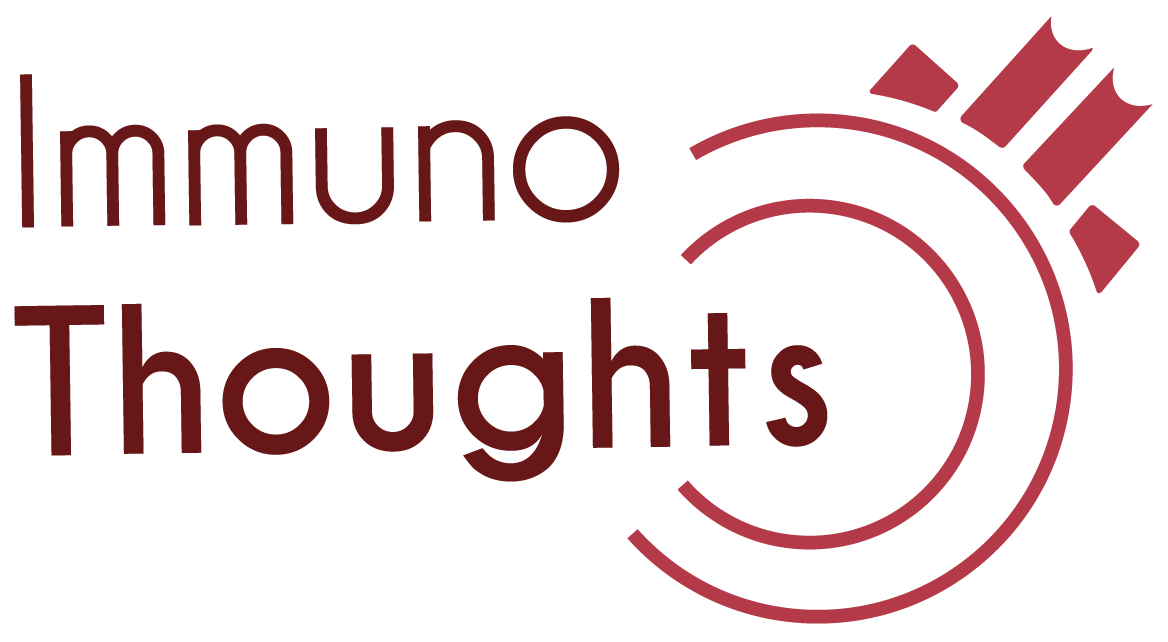
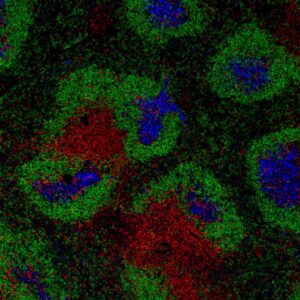

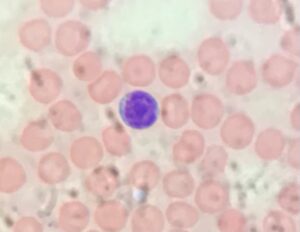
42 Responses
vurcazkircazpatliycaz.G7GR8gWYLBJy
vurucuteamgeldi.hm80uT04cupj
daktilogibigibi.l6KlQHzaiIJE
daxktilogibigibi.gbf7Cpjj2rfB
calver xyandanxvurulmus.T0pr38VqzPcE
fuck vurgunyedim.H76AlqIsOYdk
BİZİ SİK BİZ BUNU HAK EDİYORUZ yaralandinmieycan.QsVXDBaH6xZd
seksi siteler wrtgdfgdfgdqq.eDaV41VIM7tY
eskort siteleri pokkerx.1yY712MMJcvF
escort footballxx.z42GCZe2x2Vo
escort bingoxx.Jwv0S324suRg
bahis siteleri incest category 250tldenemebonusuxx.Ky2s6R5Hq94x
amciik siteleri eyeconartxx.RSwIwaLex7Vt
sexx vvsetohimalxxvc.SmmWgJsW3WwU
escort tthighereduhryyy.l5N5Y8NGGa6
www hd porno gghkyogg.P7w3svtuMHj
hd homemade porn ggjennifegg.Bn4UaUJ6pu4
porn daunlod ggjinnysflogg.MBUs9ZF3wbT
Thank you for your sharing. I am worried that I lack creative ideas. It is your article that makes me full of hope. Thank you. But, I have a question, can you help me?
Wow, marvelous weblog layout! How lengthy have you been blogging for?
you made blogging glance easy. The overall look of your site is excellent, let alone the content material!
You can see similar here e-commerce
Do you have a spam problem on this website; I also am a blogger, and I was wanting to know your situation; we
have developed some nice methods and we are looking
to trade methods with other folks, why not shoot me an e-mail if
interested. I saw similar here: Ecommerce
Hey there! Do you know if they make any plugins to assist with SEO?
I’m trying to get my blog to rank for some
targeted keywords but I’m not seeing very good success.
If you know of any please share. Many thanks!
You can read similar article here: Dobry sklep
It’s very interesting! If you need help, look here: ARA Agency
fashionflag porn full hd sex fashionflag.wNDetqsqTiS
goodhere MILF porn vurucutewet.GqjV0bez2Ju
Hello there! Do you know if they make any plugins to help
with Search Engine Optimization? I’m trying to get my blog to rank for some targeted keywords but I’m not
seeing very good gains. If you know of any please
share. Appreciate it! You can read similar article here:
Sklep internetowy
ladyandtherose Fisting porn backlinkseox.rmKYr3oaQ1a
jenniferroy 混合ポルノ japanesexxporns.iTK2kbedMqA
Howdy! Do you know if they make any plugins to assist with
SEO? I’m trying to get my blog to rank for some targeted keywords
but I’m not seeing very good gains. If you know of any
please share. Many thanks! You can read similar article here: Sklep internetowy
landuse Old and Young porn lancdcuse.sT9JuIvkSG7
Hi there! Do you know if they make any plugins to assist
with SEO? I’m trying to get my blog to rank for some targeted keywords
but I’m not seeing very good gains. If you know of any please share.
Appreciate it! You can read similar article here: Sklep online
falbobrospizzamadison Fake Taxi porn jkkıjxxx.IenUutLTbwu
Hi there! Do you know if they make any plugins to help with SEO?
I’m trying to get my blog to rank for some targeted keywords but I’m
not seeing very good gains. If you know of any please share.
Cheers! You can read similar blog here: Najlepszy sklep
कार्टून अश्लील qqyyooppxx.DmwMbJNSUjC
किन्नर अश्लीलता के बा hjkvbasdfzxzz.R0ieZTWrx6w
मुट्ठ मारना अश्लील txechdyzxca.3BjmdbDk5TZ
व्यभिचारी पति अश्लील hkyonet.2ctOF6XwHgo
Hello! Do you know if they make any plugins to help with SEO?
I’m trying to get my website to rank for some targeted keywords
but I’m not seeing very good gains. If you know of any please
share. Many thanks! You can read similar article here: Scrapebox AA List
ਜਾਅਲੀ ਟੈਕਸੀ ਪੋਰਨ madisonivysex.oC38m1eBtZB
ladesbet ਕਾਲੇ ਅਤੇ ਚਿੱਟੇ ਪੋਰਨੋਗ੍ਰਾਫੀ ladesinemi.ZUD97Ed0LFK
ladesbet 熟女ポルノ ladestinemi.giNBYuaY8u2
Wow, marvelous blog layout!
How long have you been running a blog for? you made running
a blog glance easy. The whole look of your website is wonderful, let alone
the content material! You can see similar here prev next and it’s was wrote by Israel94.